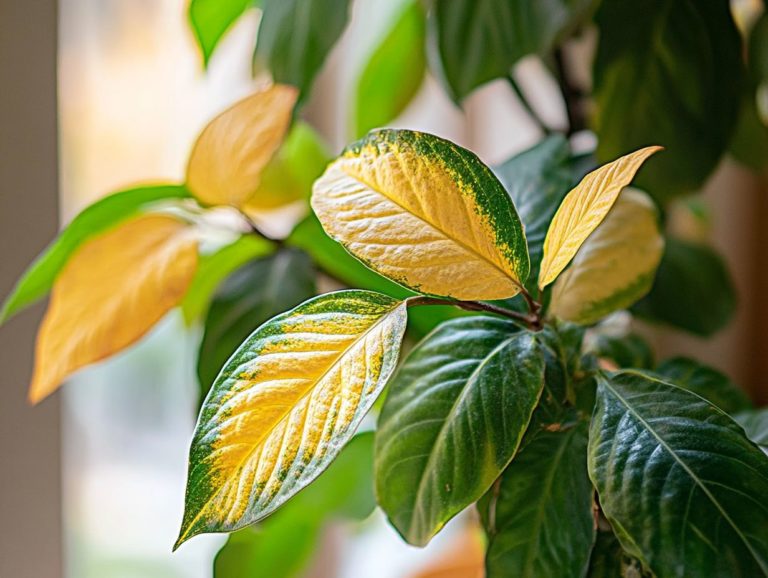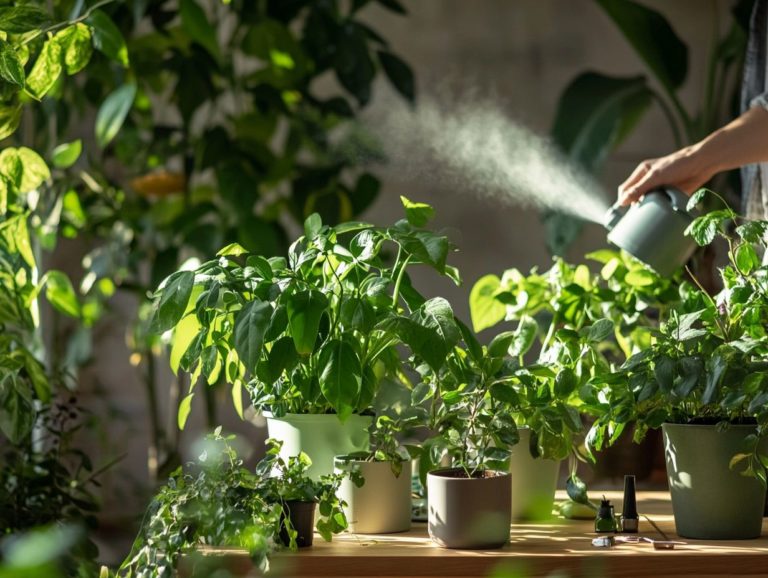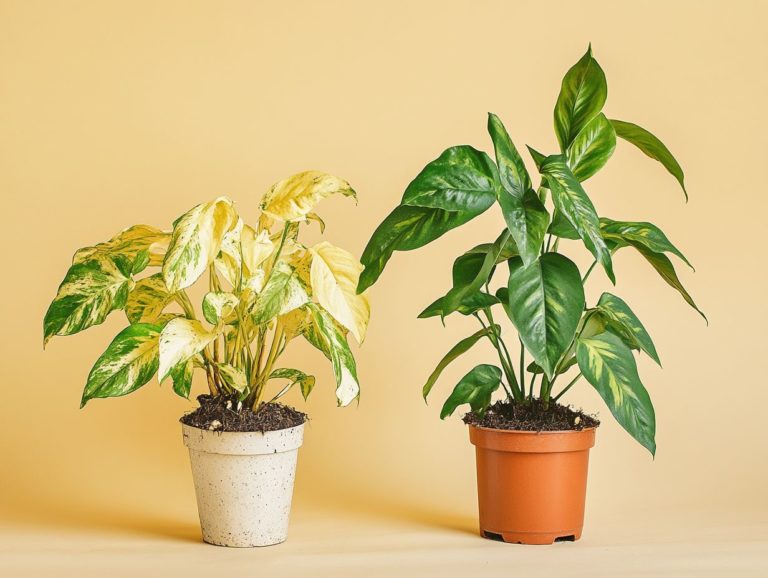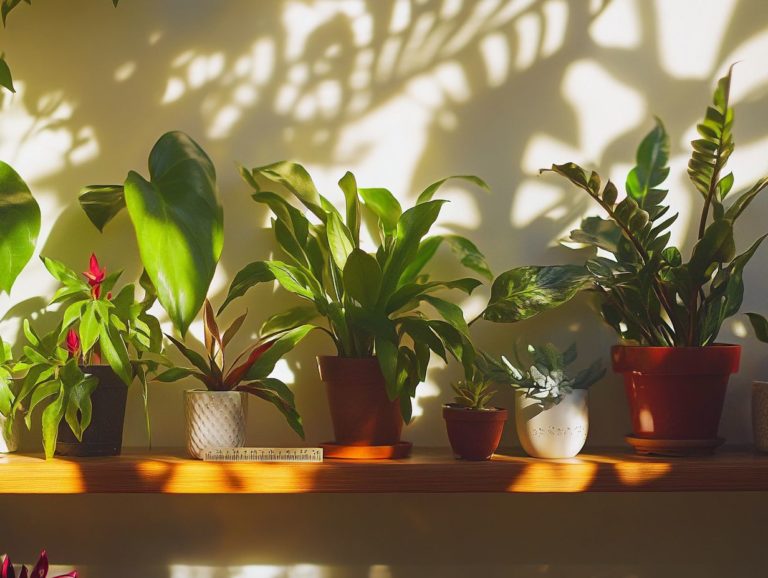How to Manage Indoor Plant Care During Winter
As winter approaches, tending to your house plants demands a thoughtful strategy to help them flourish during the colder months.
From cleaning and pruning to fine-tuning their watering and light requirements, every detail counts in this delicate balance. This guide will walk you through common winter care mistakes to sidestep, special considerations tailored for different plant needs, and effective pest control techniques.
You ll also uncover inventive ways to keep your indoor garden vibrant and visually stunning throughout the season, ensuring they receive adequate sunlight exposure even in low light. Prepare to nurture your plants and ensure their health and beauty remain intact this winter!
Contents
- Key Takeaways:
- Preparing Your Indoor Plants for Winter
- Common Winter Plant Care Mistakes
- Special Considerations for Different Types of Plants
- Dealing with Pests and Diseases in Winter
- Creative Ways to Display Indoor Plants in Winter
- Frequently Asked Questions
- How can I prevent my indoor plants from dying during winter and ensure optimal humidity?
- What should I do if my indoor plants are not getting enough sunlight during winter?
- How often should I water my indoor plants during winter?
- What can I do to increase humidity for my indoor plants during winter?
- Should I fertilize my indoor plants during winter?
- Can I repot my indoor plants during winter?
Key Takeaways:
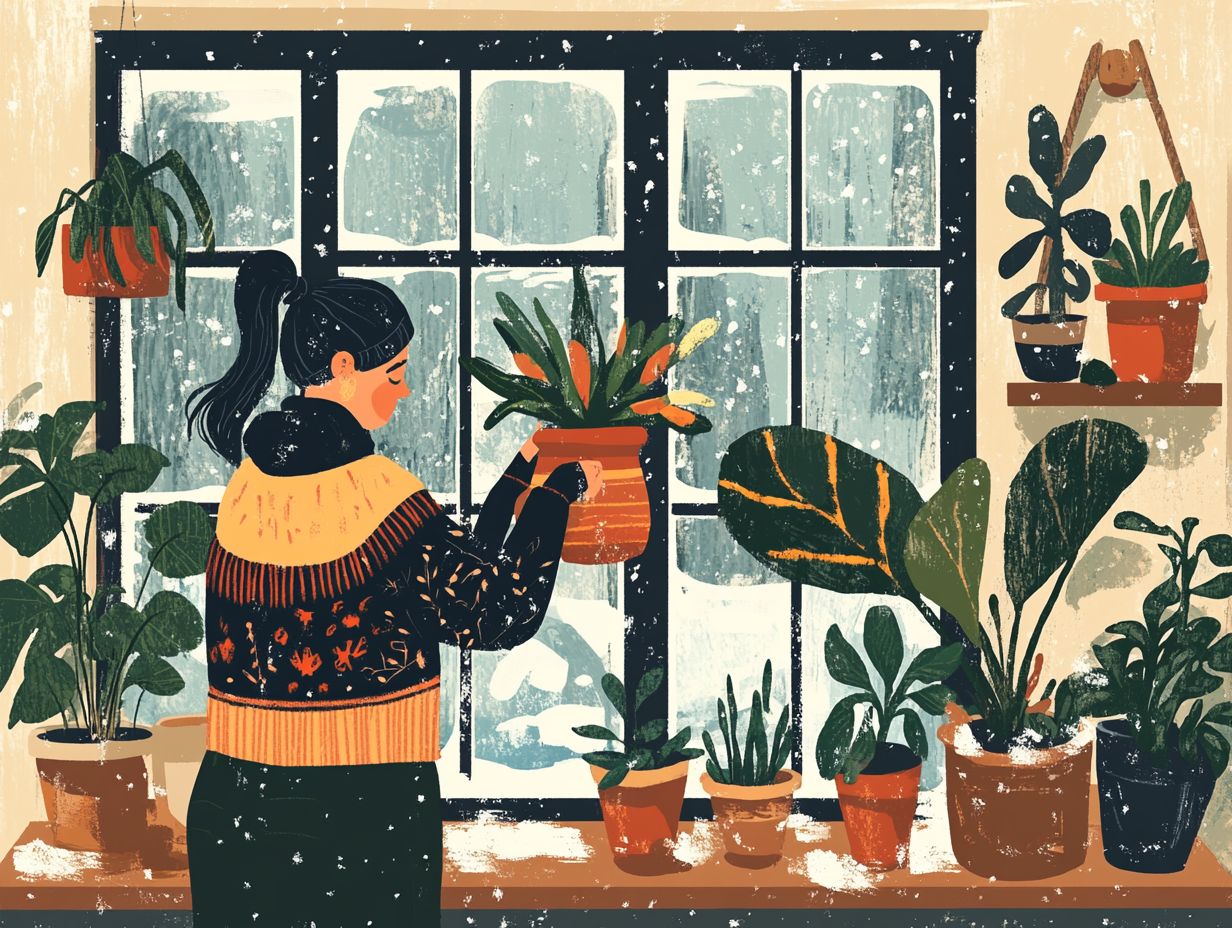
- Clean and prune your indoor plants before winter to promote healthy growth and prevent house plant pests infestations.
- Adjust watering and light levels for each plant during winter to prevent over or under-watering and ensure adequate light exposure.
- Consider the specific needs of different types of plants, such as tropical plants and succulents, during winter, including humidity levels and temperature extremes.
Preparing Your Indoor Plants for Winter
As winter draws near, it s essential to prepare your indoor plants for the colder climate they will soon encounter. House plants demand your special attention during this season to ensure they receive the right amounts of sunlight, humidity, and temperature adjustments crucial for their well-being.
Knowing what your plants need in winter is key to helping them thrive!
Cleaning and Pruning
Cleaning and pruning are essential steps in getting your indoor plants ready for winter. This ensures they stay healthy and vibrant throughout the colder months.
Make sure to carefully clean each leaf, removing dirt and debris that can hinder light absorption. Using a soft cloth or a gentle spray of lukewarm water will breathe new life into the foliage, enhancing photosynthesis, which is how plants make their food with sunlight.
Strategic pruning is also important; it not only eliminates dead or damaged leaves but also encourages new growth. This allows your plants to channel their energy more efficiently.
This thoughtful combination of thorough leaf cleaning and timely pruning greatly enhances the overall vigor of your plants, minimizing the chances of leaf drop and promoting lush, thriving foliage as the seasons change.
Adjusting Watering and Light
Adjusting your watering routine and light exposure is crucial when you’re caring for indoor plants during the winter months. As climate conditions shift, many house plants require modifications to their watering schedules.
They may benefit immensely from grow lights to ensure they receive adequate sunlight while avoiding the risk of root rot.
It s essential to evaluate the unique needs of each plant, especially as indoor humidity levels drop and temperatures fluctuate. Some plants may need less frequent watering due to drier air, while others might crave more hydration to thrive.
Incorporating tools like moisture meters can offer valuable insight into the soil’s health. This allows you to make precise adjustments based on actual moisture levels instead of relying on guesswork.
By closely monitoring these factors, you can create a healthier environment for your indoor plants, fostering growth and reducing stress on your leafy companions throughout the harsh winter months.
Common Winter Plant Care Mistakes
Many plant enthusiasts often fall into the trap of common winter plant care mistakes that can significantly affect their indoor garden. One of the most frequent issues is overwatering, as indoor plants typically need less moisture in the colder months due to reduced light and lower humidity levels.
On the flip side, underwatering can also creep in if plants aren t monitored closely. This can result in leaf loss and a decline in overall health.
With these tips, your house plants will thrive all winter long! Get started today!
Overwatering and Underwatering
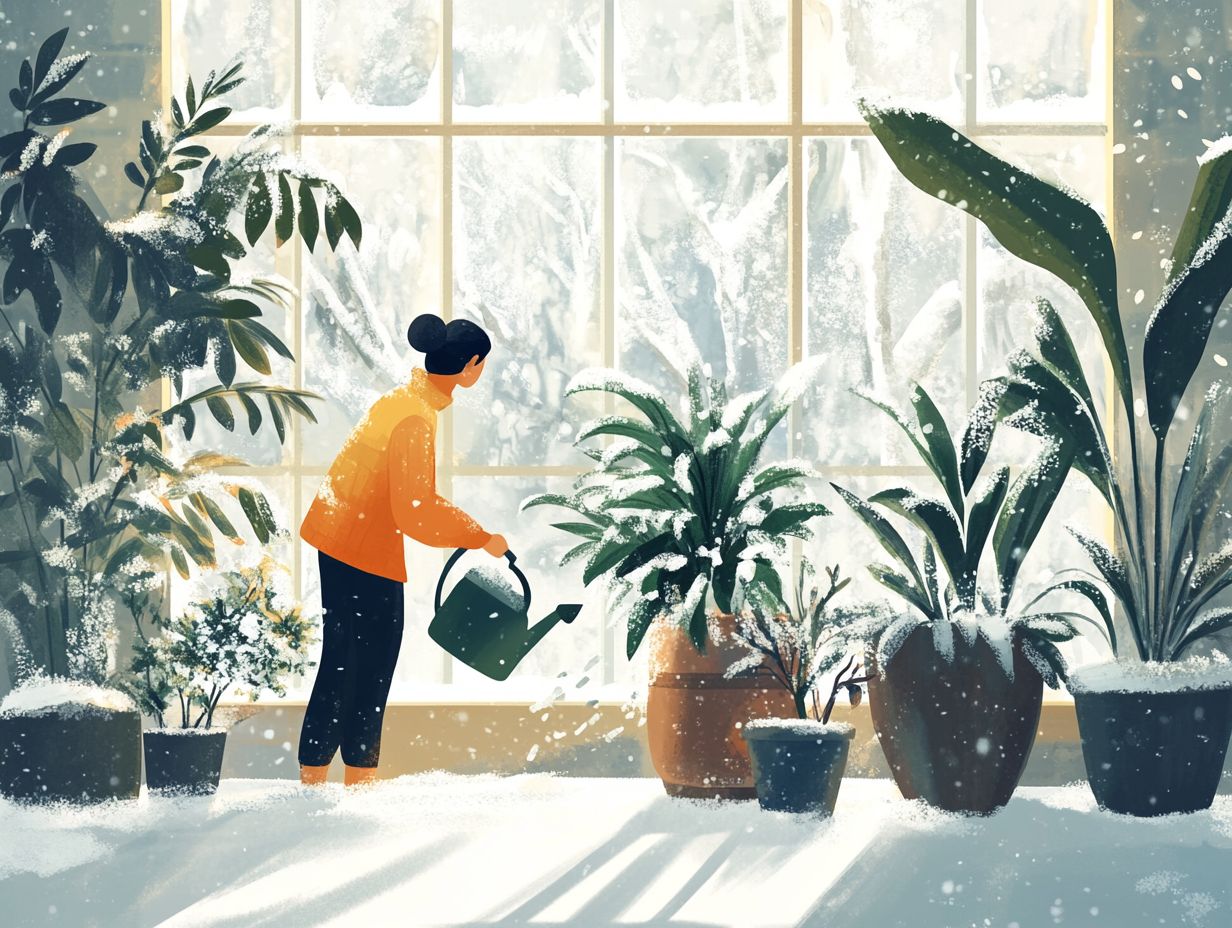
Overwatering and underwatering are two critical challenges that can affect your indoor plants during winter, potentially leading to root rot or leaf drop, Ensuring your indoor garden receives the right amount of water is essential for maintaining plant health and preventing unnecessary stress.
Recognizing the signs of these conditions is crucial for your success as a houseplant enthusiast. Look out for yellowing of leaves, wilting, and yellowing leaves, which often indicate overwatering. Conversely, browning leaf tips and soil that feels bone dry suggest underwatering.
To eliminate the guesswork when it comes to watering, consider employing a soil moisture meter. This handy tool provides accurate moisture readings, ensuring your plants achieve the perfect hydration balance.
During the winter months, adjust your watering schedule based on your specific indoor climate. Heat sources can quickly dry out the air, leading to increased evaporation, so monitoring moisture levels becomes even more essential.
Not Providing Enough Light
Not providing enough light is a common pitfall for indoor gardeners during the winter months, when natural sunlight tends to be elusive. Many houseplants, especially tropical varieties, thrive on adequate sunlight exposure, so you’ll need to add supplemental grow lights to keep them thriving!
When light is insufficient, you might notice stunted growth, yellowing leaves, and, in the worst-case scenario, the heartbreaking loss of your beloved plants. To combat these issues and ensure your indoor garden flourishes, consider placing your plants near windows where they can soak up whatever sunlight is available, even if it s just a sliver.
Investing in grow lights specifically designed for plants can dramatically improve their growth. These lights simulate sunlight, which is essential for plant growth, particularly during those dreary winter days when natural light is in short supply.
By thoughtfully positioning your plants and integrating artificial lighting solutions, you can cultivate an environment that nurtures thriving plant life, no matter the season.
Special Considerations for Different Types of Plants
Different types of indoor plants demand tailored care strategies during the winter months, especially tropical plants, succulents, and cacti. Understanding the unique needs of your plants is key to their success, particularly concerning humidity and temperature, to ensure their health and vitality throughout the season.
By paying attention to these details, you can create the optimal environment for your plants to thrive even when the weather outside isn’t cooperating.
Tropical Plants
Tropical plants flourish in warm and humid climates, so when winter rolls around, caring for them indoors becomes essential. These plants thrive on higher humidity levels to prevent leaf drop and maintain their lush, vibrant appearance during the colder months.
To achieve optimal humidity, aim for levels between 50% and 70%. One effective strategy is to position a humidifier nearby or use pebble trays filled with water to enhance moisture in the air.
Establishing a regular watering schedule is crucial; allow the top inch of soil to dry out between waterings. This approach not only prevents root rot but also ensures your plants receive the hydration they need.
Maintaining a stable temperature range of 65 F to 80 F will replicate their native environments, promoting healthy growth and stunning foliage.
By embracing these specific care techniques, you can cultivate a thriving tropical oasis right in your home.
Succulents and Cacti
Succulents and cacti, celebrated for their drought-resistant traits, require special attention during winter. They need revised watering routines and light considerations. These resilient plants can be surprisingly sensitive to overwatering. It’s crucial to keep a vigilant eye on their moisture levels.
As the colder season sets in, reduce the frequency of watering. Ensure the soil dries out thoroughly between cycles. A common mistake is treating these hardy plants like traditional houseplants. For those struggling with their plants, learning how to overcome indoor plant stress can be beneficial. You’ll find that succulents and cacti thrive with minimal hydration.
For optimal light exposure, place them near bright, indirect sunlight to preserve their vibrant colors. Maintain a stable temperature ideally between 60 and 75 degrees Fahrenheit to prevent shock and promote growth as the days gradually lengthen.
By following these guidelines, you can nurture your succulents and cacti throughout winter. They will emerge revitalized and ready for the warmth of spring.
Dealing with Pests and Diseases in Winter

Navigating the challenges of pests and diseases during winter can be daunting for indoor gardeners. Houseplant pests like aphids and spider mites often find the indoor environment inviting.
Keep your indoor plants vibrant with these exciting pest control strategies and proactive preventive measures.
Prevention and Treatment Methods
Implementing effective prevention and treatment methods is essential for managing houseplant pests during winter. This ensures your indoor garden remains healthy and thriving. Actively monitor your plants for signs of infestation, such as leaf drop, to mitigate potential damage.
Regular inspections are your best friend; they help you catch issues early. Focus on the undersides of leaves and the soil, common hiding spots for pests like aphids and spider mites.
Utilize organic methods like neem oil or insecticidal soap, a soap used to kill pests, to keep infestations at bay without harming your plants. Introduce beneficial insects, like ladybugs, that naturally reduce pest populations. Maintain optimal humidity levels and avoid overwatering to prevent infestations while promoting your plants’ health.
Creative Ways to Display Indoor Plants in Winter
Displaying indoor plants creatively during winter can elevate the natural beauty of your home. This provides the warm, inviting atmosphere we all seek.
Utilizing DIY planters and decorations showcases your indoor garden and crafts a distinctive aesthetic that reflects your personality and style during the winter care phase.
DIY Planters and Decorations
Creating DIY planters and decorations is a delightful way to enhance the display of your indoor plants. It infuses your home with a personal touch. These custom creations allow you to unleash your creativity while considering plant needs during seasonal changes.
Whether you’re a seasoned gardener or just starting, exploring materials like terracotta, wood, or even recycled items can lead to unique and sustainable designs that cater to your plants’ watering routine. For instance, turning old mugs into charming miniature planters adds a whimsical flair. Upcycling wooden pallets can transform them into stunning vertical gardens.
With various paints, embellishments, and tools at your disposal, crafting personalized pots becomes more than a project; it evolves into a genuine form of art. By following simple step-by-step instructions and considering plant temperature needs, you can create custom planters that beautifully complement your greenery.
Frequently Asked Questions
What are the best indoor plants for winter care?
How often should I water my succulents and cacti in winter?
What are some signs of pest infestations in houseplants?
What should I do if my indoor plants are exposed to cold drafts?
By implementing these strategies, including tips for watering during winters, you can ensure your indoor plants remain vibrant and healthy throughout the winter months. Engage with the plant care process and enjoy the beauty they bring to your home.
How can I prevent my indoor plants from dying during winter and ensure optimal humidity?
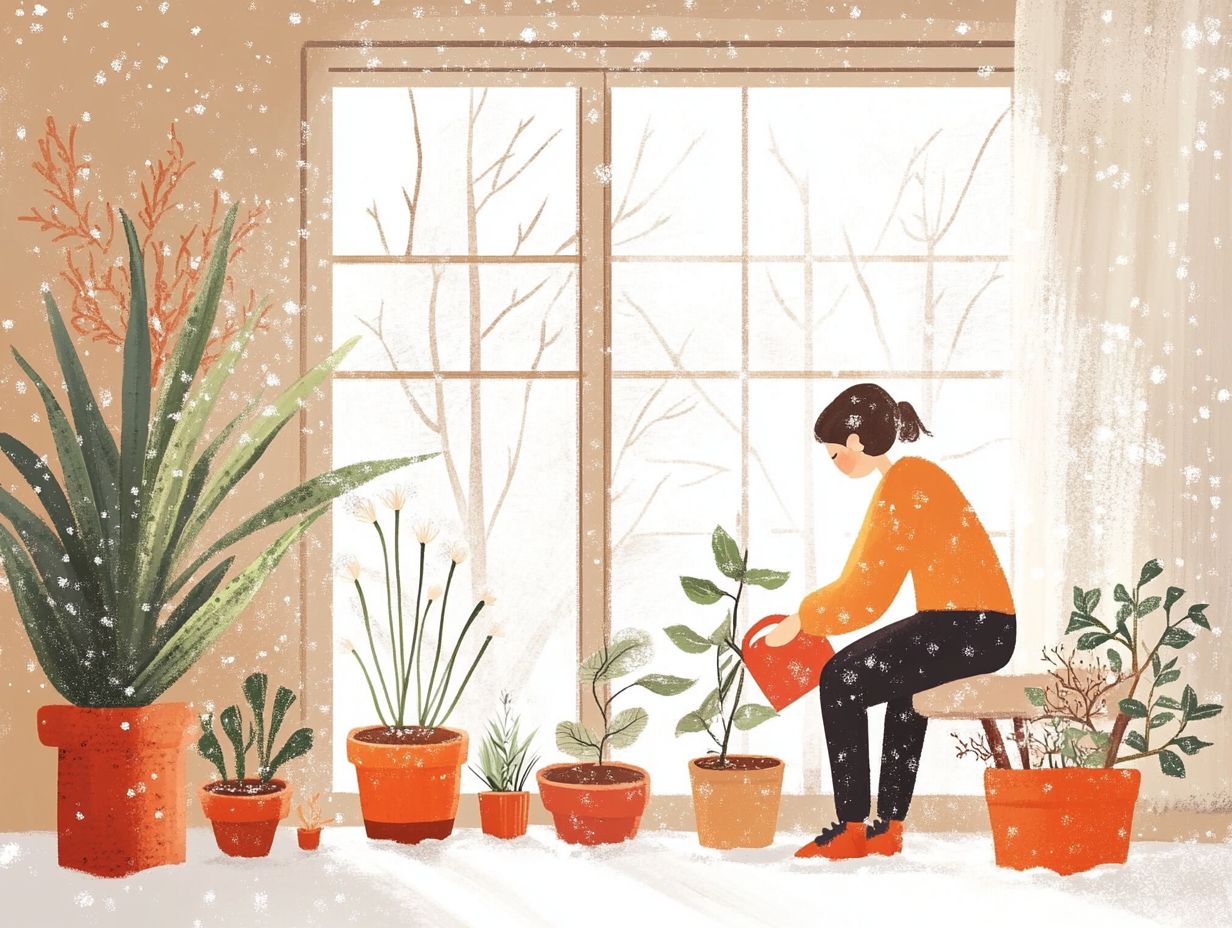
To keep your indoor plants thriving this winter, place them near a south-facing window for plenty of sunlight. If natural light isn t enough, add special lights that help plants grow indoors.
Avoid overwatering to keep your plants healthy. Maintain a stable room temperature to prevent stress from extreme cold.
What should I do if my indoor plants are not getting enough sunlight during winter?
If your indoor plants aren’t receiving enough sunlight, you can add artificial lighting. Use a grow light specifically designed for plants and keep it on for 12-14 hours a day.
Rotate your plants to ensure all sides receive adequate light, paying attention to their cleaning needs.
How often should I water my indoor plants during winter?
The frequency of watering your indoor plants during winter will depend on factors like the type of plant, the amount of light it receives, and the room temperature.
Generally, water less frequently and ensure the soil is completely dry before watering again.
What can I do to increase humidity for my indoor plants during winter?
Indoor air tends to be drier during winter, which can harm your plants. To increase humidity, group your plants together, place a tray of water nearby, or use a humidifier.
You can also mist your plants regularly, but avoid misting directly on the leaves to prevent fungal growth.
Should I fertilize my indoor plants during winter?
Indoor plants typically go dormant during winter, so fertilization is not necessary. If your plants show signs of new growth, you can use a diluted, balanced fertilizer to support them.
Make sure to follow the fertilizer instructions carefully.
Can I repot my indoor plants during winter?
It is generally not recommended to repot your indoor plants during winter as it can stress the plant. However, if your plant has outgrown its pot or shows signs of distress, you can carefully repot it using fresh potting soil and a slightly larger pot.
Be sure to avoid disturbing the roots as much as possible.

